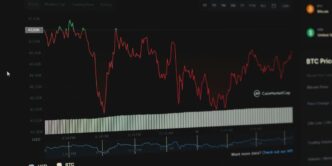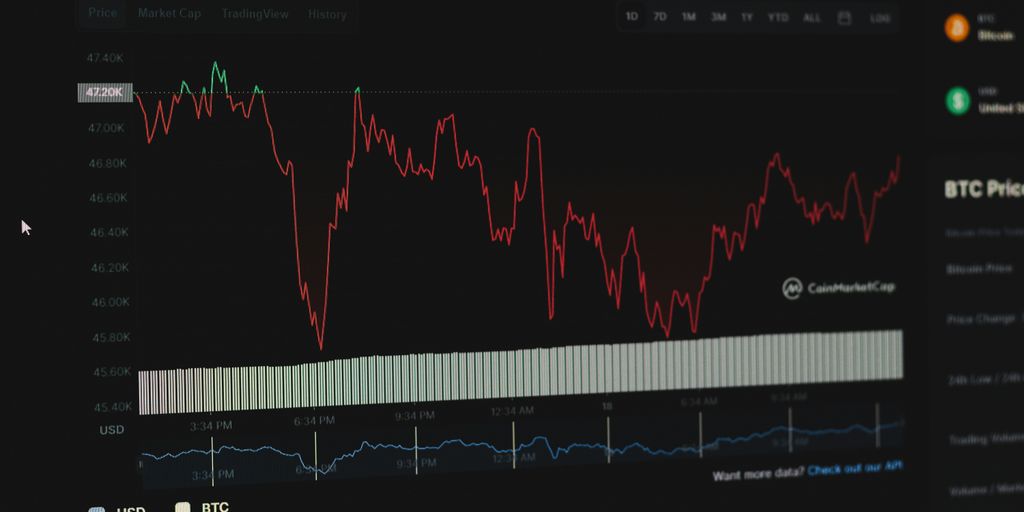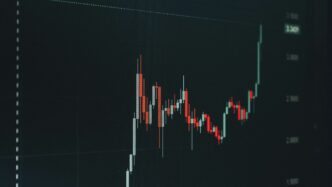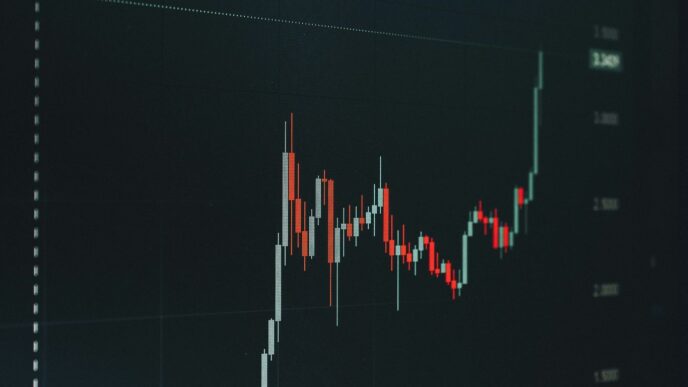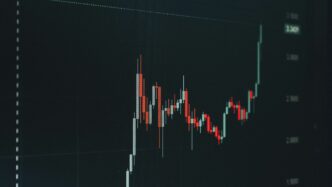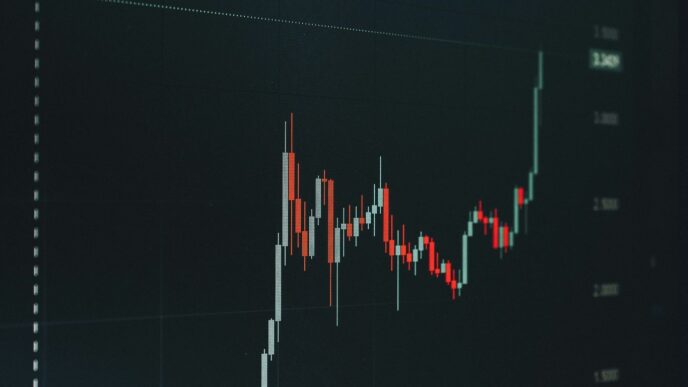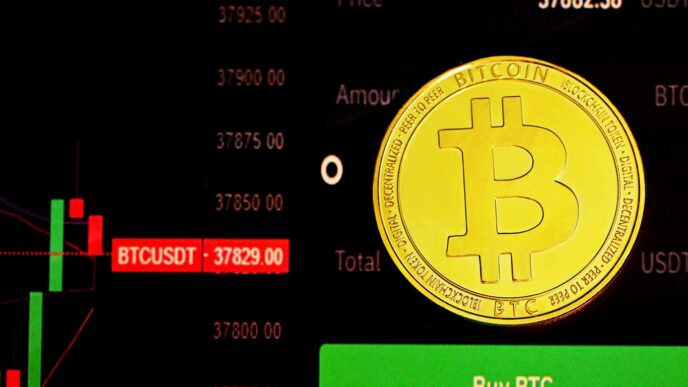Ever wonder what’s going on in the crypto world beyond Bitcoin and Ethereum? It’s easy to get caught up in the big names, but there’s a whole universe of smaller coins out there. We’re going to talk about the crypto total market cap excluding top 10 coins. This part of the market, often called ’emerging alts,’ can be a bit wild, but it also has some neat chances for growth. Let’s dig into what makes these coins tick and why they matter.
Key Takeaways
- The crypto total market cap excluding top 10 coins (like TOTAL2 and TOTAL3) helps us see how smaller cryptocurrencies are doing, separate from the big players.
- Looking at these smaller coins can show you new ways to grow your money and spread out your investments in the crypto market.
- Watching trends in this area, like price changes and how much is being traded, can give you clues about where the market might go next.
- Things like new tech, how active a project’s community is, and where a coin is listed can really affect how well these smaller coins perform.
- Investing in these emerging coins comes with risks, like big price swings, so it’s important to do your homework and have a plan to manage those risks.
Defining the Crypto Total Market Cap Excluding Top 10
Understanding TOTAL2 and TOTAL3 Metrics
Okay, so when people talk about the crypto market, they often throw around terms like "total market cap." But what does that really mean when we’re trying to figure out what’s happening with smaller altcoins? That’s where TOTAL2 and TOTAL3 come in. TOTAL is the overall market cap of crypto. TOTAL2 is the total market cap excluding Bitcoin. TOTAL3 goes a step further and excludes both Bitcoin and Ethereum. These metrics give a clearer picture of the money flowing into altcoins, especially the smaller ones. It’s like looking at a company’s performance without including its most profitable product line – you get a better sense of how the other products are doing.
The Significance of Excluding Top Cryptocurrencies
Why bother excluding Bitcoin and Ethereum? Well, those two are giants. Their price movements can overshadow everything else. If Bitcoin has a bad day, it can drag the whole market down, even if smaller altcoins are doing well. By excluding them, we can see the true strength (or weakness) of the altcoin market. It’s like trying to judge the health of a forest by only looking at the two biggest trees. You’d miss all the interesting stuff happening on the forest floor. This approach helps in understanding crypto market capitalization more accurately.
Identifying the ‘Emerging Alts’ Segment
So, who are these "emerging alts" we’re talking about? They’re basically the cryptocurrencies outside the top 10 by market cap. These are the projects with smaller market caps, newer technologies, and often, higher risk but also higher potential reward. Think of them as the startups of the crypto world. They might be working on innovative solutions, building passionate communities, or trying to disrupt existing industries. Identifying them involves looking beyond the usual suspects and digging into the projects that are just starting to gain traction. It’s about finding the next big thing before everyone else does. Here’s a few things to look for:
- Market Cap: Usually outside the top 10, often below a billion dollars.
- Age: Relatively new projects, launched within the last few years.
- Innovation: Trying to solve a real-world problem or introduce a new technology.
Why Focus on Emerging Altcoins?
Unlocking Growth Potential Beyond Established Assets
Let’s be real, Bitcoin and Ethereum have already seen massive growth. While they still have potential, emerging altcoins offer the chance for exponential returns. Think of it as getting in on the ground floor of something big. These smaller projects often have lower market caps, meaning there’s more room for them to grow significantly if they gain traction. It’s like investing in a startup versus a well-established corporation. The startup carries more risk, but the potential reward is much higher. You can find opportunities in low-cap altcoins if you know where to look.
Diversification Benefits in a Volatile Market
Putting all your eggs in one basket is never a good idea, especially in the crypto world. Diversifying your portfolio with emerging altcoins can help mitigate risk. When Bitcoin dips, some altcoins might actually go up, or at least not fall as much. This is because they may be driven by different factors, such as specific project developments or community hype. It’s about spreading your bets across different areas of the market to reduce the impact of any single asset’s performance. A well-diversified portfolio can weather the storms of crypto volatility much better than one concentrated in just a few major coins.
Identifying Early Investment Opportunities
Being early to a promising project can be incredibly rewarding. Emerging altcoins often represent innovative ideas and technologies that haven’t yet been fully recognized by the market. By doing your research and identifying these projects early, you can position yourself to benefit from their future success. This requires a keen eye for spotting potential, understanding the technology behind the project, and assessing the team’s ability to execute their vision. It’s like being a venture capitalist in the crypto space, seeking out the next big thing before everyone else does. Keep an eye on community engagement to see what projects are gaining traction.
Analyzing Market Trends in the Emerging Altcoin Space
Interpreting Price Action and Volume Indicators
Okay, so you’re looking at a chart for some random altcoin. What do you even do with it? Well, first, pay attention to price action. Is it choppy? Is it steadily climbing? Big green candles are usually good, big red candles, not so much. But don’t just look at the candles themselves. Check out the volume. High volume on a price increase suggests strong buying pressure. Low volume? Could be a fakeout. Volume confirms the strength of a price trend. Think of it like this: if only a few people are buying, the price might go up, but it’s not sustainable. You want to see a lot of people getting in on the action.
Recognizing Bullish and Bearish Formations
Chart patterns are like reading tea leaves, but for crypto. Some people swear by them, others think they’re nonsense. Either way, it’s good to know the basics. A "cup and handle" is generally considered bullish, while a "head and shoulders" pattern is usually bearish. Double tops and bottoms can signal reversals. But here’s the thing: these patterns aren’t foolproof. Always confirm with other indicators and, you know, common sense. Don’t blindly trust a pattern just because it looks right. Look for confirmation. For example, a breakout from a bullish flag pattern should ideally be accompanied by a surge in volume.
The Impact of Macroeconomic Factors on Emerging Alts
Crypto doesn’t exist in a vacuum. What happens in the real world affects even the most obscure altcoins. Interest rates, inflation, and overall economic sentiment can all play a role. If the stock market is tanking, people might pull money out of crypto too, even if that connected mining market is booming. Conversely, if there’s a lot of money sloshing around, some of it might find its way into riskier assets like emerging altcoins. Keep an eye on the news and try to understand how broader economic trends might impact your investments. It’s not always a direct correlation, but it’s definitely something to consider. Here’s a quick rundown:
- Interest Rates: Higher rates can reduce liquidity, impacting crypto.
- Inflation: Can drive investors to alternative assets, including crypto.
- Regulatory Changes: New regulations can create uncertainty or boost confidence.
Key Factors Influencing Emerging Altcoin Performance
Technological Innovation and Project Utility
Does the altcoin actually do anything useful? That’s the big question. The underlying tech needs to be solid and offer something new or better than what’s already out there. I always check the project’s whitepaper – it should clearly explain what they’re trying to achieve and how their tech works. If it’s just buzzwords and no substance, that’s a red flag. For example, is the blockchain efficient?
Community Engagement and Developer Activity
A strong community can make or break an altcoin. Are people actually using it and talking about it? Is there active development happening? I look for active social media channels, forums, and, if possible, a peek at their GitHub to see how often the developers are updating the code. A dead community or inactive developers usually means the project is going nowhere. Community engagement and viral marketing are key.
Liquidity Dynamics and Exchange Listings
Liquidity is super important. If you can’t easily buy or sell an altcoin, it doesn’t matter how great the tech is. You want to see it listed on reputable exchanges with decent trading volume. Low liquidity can lead to wild price swings and make it hard to get out when you want to. Here’s a quick rundown of what I look for:
- Exchange Listings: Are they on major exchanges like Binance, Coinbase, or Kraken? Or only on smaller, less trustworthy ones?
- Trading Volume: What’s the daily trading volume? Higher volume means more liquidity.
- Order Book Depth: How many buy and sell orders are there at different price levels? A deep order book means less slippage when you trade.
Basically, you want to make sure you can actually buy Dogelend when you want to, and sell it without losing a ton of money in the process.
Navigating Risks in the Emerging Altcoin Market

Understanding Volatility and Price Swings
Okay, so you’re thinking about diving into emerging altcoins? Cool! But first, let’s be real: these things are volatile. Like, really volatile. Price swings can be massive and happen super fast. One minute you’re up 20%, the next you’re down 30%. It’s just part of the game. You need to be prepared for that emotional rollercoaster. It’s not for the faint of heart, and you should never invest more than you can afford to lose. Keep an eye on the crypto fundamental analysis to help you make informed decisions.
Mitigating Risks Through Due Diligence
So, how do you not get totally wrecked in the emerging altcoin market? Due diligence, my friend. Due diligence. Don’t just throw money at the first shiny new coin you see. Do your homework. Seriously. Here’s a quick checklist:
- Research the team: Who are these people? What’s their background? Are they legit, or are they anonymous randos?
- Understand the project: What problem is this altcoin trying to solve? Is it a real problem? Does the solution make sense?
- Read the whitepaper: Yes, it’s probably full of jargon, but try to understand the basics. What’s the technology? What’s the roadmap?
- Check the community: Is there an active community? Are people excited about the project, or is it a ghost town?
If you can’t answer these questions, you probably shouldn’t be investing.
The Importance of Risk Management Strategies
Alright, you’ve done your research, and you’re ready to invest. Great! But don’t forget about risk management. This is where things get real. Here are a few strategies to consider:
- Diversify: Don’t put all your eggs in one basket. Spread your investments across multiple altcoins. That way, if one goes to zero (and some will go to zero), you’re not totally wiped out.
- Set stop-loss orders: This is crucial. A stop-loss order automatically sells your altcoin if it drops to a certain price. This can help you limit your losses if the market turns against you.
- Take profits: Don’t get greedy. If an altcoin goes up a lot, take some profits off the table. You can always buy back in later if you think it’s going to keep going up. Remember that liquidity conditions can change quickly.
- Dollar-Cost Averaging (DCA): Instead of buying a large amount at once, buy a little bit at regular intervals. This helps smooth out the price volatility.
Remember, investing in emerging altcoins is risky. There are pump-and-dump schemes to watch out for. But with proper research and risk management, you can increase your chances of success. Good luck, and be careful out there!
Strategies for Investing in Emerging Altcoins
Researching Promising Projects and Use Cases
Okay, so you’re thinking about throwing some cash at these baby altcoins? Smart move, maybe. But first, you gotta do your homework. I’m not talking about skimming a whitepaper while you’re waiting for your coffee. I mean really digging in. What problem is this coin trying to solve? Does it even solve it well? Is there a real-world application, or is it just hype? Look at the team behind it – are they experienced, or are they just a bunch of kids with a dream and a server? Don’t just listen to the echo chamber on Crypto Twitter; find independent sources and form your own opinion.
- Read the whitepaper (yes, all of it).
- Check out the team’s background on LinkedIn.
- See if the project has a working product or just promises.
Considering Long-Term Versus Short-Term Holdings
Alright, are you in this for the long haul, or are you just trying to make a quick buck? There’s no right or wrong answer, but you need to know your game plan. Long-term cryptocurrency fundamental analysis means you believe in the project’s potential and are willing to ride out the ups and downs. Short-term means you’re trying to catch a wave and get out before it crashes. If you’re going long, you need to be even more confident in the project’s fundamentals. If you’re going short, you need to be glued to the charts and ready to pull the trigger at a moment’s notice. I’ve tried both, and let me tell you, both can be stressful.
- Long-term: Requires strong conviction and patience.
- Short-term: Requires technical analysis skills and quick reflexes.
- Consider your risk tolerance and time commitment.
Portfolio Allocation for Emerging Altcoins
Okay, so you’ve picked a few altcoins that you think are going to moon. Great! Now, don’t go throwing your entire life savings at them. These things are risky! A good rule of thumb is to only allocate a small percentage of your portfolio to emerging altcoins. I’m talking single digits, maybe 5-10% max. That way, if one of them goes belly up (and trust me, some of them will), it’s not going to ruin you. Think of it like playing poker – you only bet what you can afford to lose. Diversification is key. Don’t put all your eggs in one basket, especially when that basket is made of volatile crypto.
- Limit your allocation to a small percentage of your portfolio.
- Diversify across multiple altcoins.
- Rebalance your portfolio regularly to maintain your desired allocation.
The Future Outlook for the Crypto Total Market Cap Excluding Top 10
Anticipating Future Growth and Adoption
Okay, so what’s next for the smaller cryptos? I think we’re going to see some interesting stuff. The total market cap excluding the big guys has a lot of room to grow. It really depends on whether people start trusting these smaller projects. If more people start using them for actual stuff, not just trading, then we could see some serious growth. Think about it: new tech, new ideas, and a whole lot of potential.
The Role of Regulatory Developments
Regulations are a big deal. Seriously. If governments start cracking down, it could squash a lot of these smaller projects. But, if they come up with some clear rules that aren’t too harsh, it could actually help. People like knowing the rules, and clear rules could bring in more serious investors. It’s a double-edged sword, for sure. We need to keep an eye on what the SEC and other agencies are doing. Understanding cryptocurrency and Bitcoin regulations is key to predicting market behavior.
Predicting the Next Altcoin Season
Everyone’s waiting for the next "altcoin season," right? It’s when all the smaller coins go crazy and people make a ton of money (or lose it all!). It’s tough to say exactly when it’ll happen, but it usually follows Bitcoin doing its thing. If Bitcoin chills out for a bit, people start looking for the next big thing, and that’s when the smaller coins can take off. Keep an eye on Bitcoin’s price and the overall market mood. When people get bored with Bitcoin, that’s your cue. Also, watch out for new tech or projects that get a lot of buzz. Those are usually the ones that lead the charge. It’s all about timing and a little bit of luck. Here’s a few things to consider:
- Bitcoin’s stability (or lack thereof)
- New project launches and hype
- Overall market sentiment
And remember, it’s crypto, so anything can happen!
Conclusion
So, what’s the big takeaway here? Looking at the crypto market cap without the top 10 coins, often called TOTAL3, gives us a pretty good idea of what’s happening with smaller, newer altcoins. It’s like checking the pulse of the whole crypto world beyond just Bitcoin and Ethereum. This number can tell you if people are feeling good about taking risks on new projects or if they’re playing it safe. It’s not a crystal ball, but it helps you see trends. Keeping an eye on TOTAL3 can help you make better choices in the crypto space, especially if you’re interested in those coins that aren’t always in the headlines.
Frequently Asked Questions
What are TOTAL2 and TOTAL3, and why do they matter?
TOTAL2 is a number that shows the total value of all cryptocurrencies, but it leaves out Bitcoin. Think of it as a way to measure the ‘altcoin’ market, which includes everything else besides Bitcoin. TOTAL3 goes a step further and also leaves out Ethereum, giving you an even clearer picture of the smaller, emerging altcoins.
Why should I care about cryptocurrencies beyond the top 10?
Focusing on these emerging altcoins can open up new chances for big growth. Since they’re smaller, they have more room to grow than the big, established coins. It’s like finding a small, promising company before it becomes a huge success.
Are these emerging altcoins risky to invest in?
These smaller coins can be very jumpy. Their prices can go up and down a lot, much more than bigger coins. This means there’s a chance for big wins, but also big losses. It’s important to be careful and do your homework.
How can I find good emerging altcoin projects?
To find good emerging altcoins, look for projects with new ideas or useful technology. Check if a lot of people are using them and if the creators are actively working on them. Also, see if they’re easy to buy and sell on popular exchanges.
What’s the best way to handle the risks with these smaller coins?
It’s super important to not put all your eggs in one basket. Spread your money across different projects. Also, only invest money you can afford to lose, because these markets can be very unpredictable.
What does the future hold for the market of emerging altcoins?
The future looks bright for these emerging altcoins, especially as more people learn about crypto and new technologies come out. However, new rules from governments could also change things. Keeping an eye on these trends will help you understand where the market might be headed.

